Somewhere in the wet pine forests of Chile, a male frog is gulping-up a bunch of eggs. No he’s not eating them, he’s just being a good dad. Darwin’s frogs are known for their unique parenting-style: tadpoles are incubated in the vocal sac of the father. First recorded by Charles Darwin during his world famous voyage aboard the Beagle, the amphibians were common in the native Chilean pine forests until the last few decades. Now, scientists believe that one of the two species, the northern Darwin’s frog (Rhinoderma rufum), may have vanished for good. And the other is hanging on by a thread.
“If Rhinoderma rufum is extinct, this will become the first extinction of an endemic vertebrate species in Chile,” Claudio Soto-Azat told mongabay.com. The lead author of a new paper in PLoS ONE on the two species, Soto-Azat with Andres Bello Universiy in Santiago, adds that, “Hope remains that the species still survives at an inaccessible area.”
Scientists only separated the northern Darwin’s frog from its southern cousin in 1975 after noting several differences in the species, including how far they took the vocal sac-breeding. At this point, the northern species was already vanishing: it was last sighted in 1980.
To determine its current status, Soto-Azat and his team visited several sites where the northern Darwin’s frog was previously found, but found no individuals and heard not a single call. Modeling by the scientists suggested that the species was wiped out in 1982, just seven years after it was described as a new species.
Both northern and southern species lay eggs on the wet ground, but once the eggs hatch the male frogs swallow the tadpoles and keep them safe in their vocal sac. Doing such actually makes the fathers look pregnant. The northern species (Rhinoderma rufum) then moves the tadpoles to freshwater where it releases them. However, tadpoles undergo an extended stay in the vocal sacs of the southern Darwin’s frog (Rhinoderma darwinii), where the males keep them until they are fully grown froglets, about 50 days.

A specimen of the northern Darwin’s frog (Rhinoderma rufum), which may now be extinct. Photo by: Claudio Soto Azat.
“With the extinction of Rhinoderma rufum a unique reproductive strategy (neomelia) that took thousands of years to evolve will be lost forever,” notes Soto-Azat. “This extinction should be a warning call to society, as an indication of the extent of habitat degradation which has lead extinction of a species which was abundant in the past.”
Soto-Azat recommends that the species remain listed as Critically Endangered by the IUCN Red List, but that it is also added to a list of Potentially Extinct species. The species is also currently listed as #45 on the EDGE’s list of the top 100 most endangered and evolutionary-distinct amphibians. If it is gone, it was likely wiped out by deforestation for vast pine plantations.
“The temperate forests of central-south have almost completely disappeared as they have been mainly replaced by commercial pine and eucalypt plantations,” Soto-Azat says. “The reduction of natural forest area in the coastal range of central-south Chile has been calculated to be 67% for the period 1975–2000 and by 1993, Pinus radiata reached 1.24 million ha in central-south Chile, becoming the largest pine plantations worldwide.”
The news isn’t all that better for the southern Darwin’s frog. Currently listed as Vulnerable, Soto-Azat and colleagues say the species should be upgraded to Endangered. They documented 36 populations of the species, but they are “severely fragmented and population sizes were very small (less than 100 individuals/population).”
In some sites, including protected areas and undisturbed forests, the researchers found no sign of the frogs, despite their once being a healthy population. Like its northern cousin, this species has been devastated in parts of its range by deforestation. In addition, volcanic eruptions have killed off some populations. There are also rising concerns that climate change and a lethal amphibian disease, known as chytridiomycosis, may be impacting the species.
According to Soto-Azat more public education and additional research will be vital to saving the species from extinction. If its relative is gone, this is the world’s last frog that reproduces in this bizarre manner and only the second vertebrate on Earth whereby the males carry around the young in a pouch (the other is the seahorse).
In addition, Soto-Azat, says that its time for “all relevant stakeholders (scientists, general public, government authorities, NGOs, national and private parks, etc.) to agree on a Darwin’s frog conservation action plan.”
Given how quickly the northern Darwin’s frog vanished, time is not on our side.

The southern Darwin’s frog (Rhinoderma darwinii) is undergoing a steep decline. Photo by: Claudio Soto Azat.
CITATION: Soto-Azat C, Valenzuela-Sánchez A, Collen B, Rowcliffe JM, Veloso A, et al. (2013) The Population Decline and Extinction of Darwin’s Frogs. PLoS ONE 8(6): e66957. doi:10.1371/journal.pone.0066957.
Related articles
Amazonian students help monitor threatened frog populations
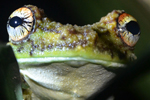
(07/01/2013) According to the International Union for Conservation of Nature, amphibians are the most threatened group of animals on Earth: currently around 30 percent of the world’s amphibians are listed as threatened with extinction. However this percentage doesn’t include those species about which too little is known to evaluate (26 percent). Amphibians face many threats but two of the largest are habitat loss and the lethal chytrid fungus, which has rapidly spread worldwide and is likely responsible for numerous extinctions. But conservationists are coming up with innovative and creative ways to keep amphibians from disappearing, including a program from the Detroit Zoological Society (DZS) that is working with students in the Peruvian Amazon to monitor frog populations.
Turning up the temperature might save frogs’ lives
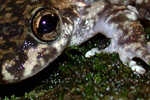
(05/28/2013) Over the past 30 years, amphibians worldwide have been infected with a lethal skin disease known as the amphibian chytrid fungus (Batrachochytrium dendrobatidis). “The disease can cause rapid mortality, with infected frogs of susceptible species dying within weeks of infection in the laboratory.” Jodi Rowley, a herpetologist with the Australian Museum told mongabay.com. “This disease has now been associated with declines and extinctions in hundreds of species of amphibians worldwide, and is a serious threat to global amphibian biodiversity.”
Scientists discover 8 new frogs in one sanctuary, nearly all Critically Endangered (photos)
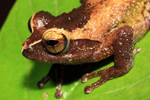
(03/21/2013) Two surveys in the mountainous forests of Sri Lank’s Peak Wilderness Sanctuary have uncovered eight new species of frogs, according to a massive new paper in the Journal of Threatened Taxa. While every year over a hundred new amphibians are discovered, eight new discoveries in a single park is especially notable. Sri Lanka is an amphibian-lovers paradise with well over 100 described species, most of which are endemic, i.e. found only on the small island country. Unfortunately the country has also seen more frog extinctions than anywhere else, and seven of the eight new species are already thought to be Critically Endangered.
Captive frogs may be spreading diseases to wild cousins across Southeast Asia
(03/07/2013) Scientists have documented a series of links between exotic frogs for trade and diseases in wild frogs in Southeast Asia, including the first documented case of the chytrid fungus—a virulent and lethal disease—in Singapore. According to researchers writing in a new study in EcoHealth, frogs imported into Southeast Asia as pets, food, or traditional medicine are very likely spreading diseases to wild populations.
Two new species of mini-salamander discovered in Colombia
(02/28/2013) Biologists have discovered two new species of salamander in Tamá National Natural Park in Colombia. While the discovery should be cause for celebration, the news was dampened by the fact that both species are already infected with the deadly fungal disease, known as Batrachochytrium dendrobatidis (Bd), which has wiped out amphibian populations worldwide. Both of the new salamanders belong to the genus Bolitoglossa, which are web-footed salamanders found in the tropical Americas.
Popular pesticides kill frogs outright
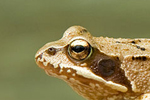
(01/28/2013) Commonly used agrochemicals (pesticides, fungicides and herbicides) kill frogs outright when sprayed on fields even when used at recommended dosages, according to new research in Scientific Reports. Testing seven chemicals on European common frogs (Rana temporaria), the scientists found that all of them were potentially lethal to amphibians. In fact, two fungicides—Headline and Captain Omya—wiped out the entire population of frogs at the recommended dosage. The study warns that agricultural chemicals could be having a large-scale and largely unrecorded impact on the world’s vanishing amphibians.
Common toads ravaged by killer disease in Portugal

(01/14/2013) The chytrid fungus—responsible for millions of amphibian deaths worldwide—is now believed to be behind a sudden decline in the common midwife toad (Alytes obstetricans), according to a new paper in Animal Conservation. Researchers have detected the presence of the deadly fungus in the Serra da Estrela, north-central Portugal, home to a population of the midwife toad.
Meet Cape Town’s volunteer ‘toad shepherds’
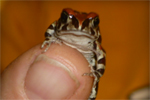
(11/08/2012) August marks the last month of winter in South Africa, and, as temperatures begin to rise, activists in Cape Town prepare for a truly unique conservation event. Every year at this time western leopard toads (Amietophrynus pantherinus) endemic to the region and Critically Endangered, embark on a night-time migration through Cape Town from their homes in the city’s gardens to the ponds they use as breeding sites—as far as three kilometers away. This season over one hundred volunteers took to the streets, flashlights in hand, to assist the toads in navigating the increasing number of man-made obstacles in their path. Among them was life-long resident and mother, Hanniki Pieterse, who serves as an organizer for volunteers in her area.
Artificial ‘misting system’ allows vanished toad to be released back into the wild
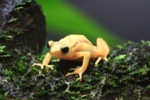
(11/01/2012) In 1996 scientists discovered a new species of dwarf toad: the Kihansi spray toad (Nectophrynoides asperginis). Although surviving on only two hectares near the Kihansi Gorge in Tanzania, the toads proved populous: around 17,000 individuals crowded the smallest known habitat of any vertebrate, living happily off the moist micro-habitat created by spray from adjacent waterfalls. Eight years later and the Kihansi spray toad was gone. Disease combined with the construction of a hydroelectric dam ended the toads’ limited, but fecund, reign.
Climate change may be worsening impacts of killer frog disease
(08/13/2012) Climate change, which is spawning more extreme temperatures variations worldwide, may be worsening the effects of a devastating fungal disease on the world’s amphibians, according to new research published in Nature Climate Change. Researchers found that frogs infected with the disease, known as chytridiomycosis, perished more rapidly when temperatures swung wildly. However scientists told the BBC that more research is needed before any definitive link between climate change and chytridiomycosis mortalities could be made.
3000 new species of amphibians discovered in 25 years
(07/31/2012) The number of amphibians described by scientists now exceeds 7,000, or roughly 3,000 more than were known just 25 years ago, report researchers in Berkeley.